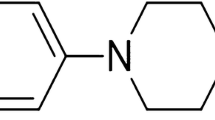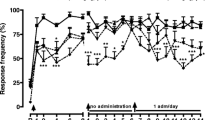Abstract
Voltage-sensitive calcium channels (VSCCs) underlie cell excitability and are involved in the mechanisms that generate and maintain neuropathic and inflammatory pain. We evaluated in rats the effects of two VSCC blockers, ω-conotoxin MVIIA and Phα1β, in models of inflammatory and neuropathic pain induced with complete Freund’s adjuvant (CFA) and chronic constrictive injury (CCI), respectively. We also evaluated the effects of the toxins on capsaicin-induced Ca2+ influx in dorsal root ganglion (DRG) neurons obtained from rats exposed to both models of pain. A single intrathecal injection of Phα1β reversibly inhibits CFA and CCI-induced mechanical hyperalgesia longer than a single injection of ω-conotoxin MVIIA. Phα1β and MVIIA also inhibited capsaicin-induced Ca2+ influx in DRG neurons. The inhibitory effect of Phα1β on capsaicin-induced calcium transients in DRG neurons was greater in the CFA model of pain, while the inhibitory effect of ω-conotoxin MVIIA was greater in the CCI model. The management of chronic inflammatory and neuropathic pain is still a major challenge for clinicians. Phα1β, a reversible inhibitor of VSCCs with a preference for N-type Ca2+ channels, has potential as a novel therapeutic agent for inflammatory and neuropathic pain. Clinical studies are necessary to establish the role of Phα1β in the treatment of chronic pain.



Similar content being viewed by others

References
Altier C, Zamponi GW (2004) Targeting Ca2+ channels to treat pain: T-type versus N-type. Trends Pharmacol Sci 25:465–470
Bennett GJ, Xie YK (1988) A peripheral mononeuropathy in rat produces disorders of pain sensation like those seen in man. Pain 33:87–107
Berridge MJ, Lipp P, Bootman MD (2000) The versatility and universality of calcium signaling. Nat Rev Mol Cell Biol 1:11–21
Bowersox SS, Gadbois T, Singh T, Pettus M, Wang YX, Luther RR (1996) Selective N-type neuronal voltage-sensitive calcium channel blocker, SNX-111, produces spinal antinociception in rat models of acute, persistent and neuropathic pain. J Pharmacol Exp Ther 279:1243–1249
Caspani O, Zurborg S, Labuz D, Heppenstall PA (2009) The contribution of TRPM8 and TRPA1 channels to cold allodynia and neurophatic pain. PLoS ONE 4:e7383
Chaplan SR, Bach FW, Pogrel JW, Chung JM, Yaksh TL (1994) Quantitative assessment of tactile allodynia in the rat paw. J Neurosci Methods 53:55–63
Cizkova D et al (2002) Localization of N-type Ca2+ channels in the rat spinal cord following chronic constrictive nerve injury. Exp Brain Res 147:456–463
Cordeiro Mdo N et al (1993) Purification and amino acid sequences of six Tx3 type neurotoxins from the venom of the Brazilian ‘armed’ spider Phoneutria nigriventer. Toxicon 31:35–42
Dixon WJ (1980) Efficient analysis of experimental observations. Annu Rev Pharmacol Toxicol 20:441–462
Eun SY, Jung SJ, Park YK, Kwak J, Kim SJ, Kim J (2001) Effects of capsaicin on Ca2+ release from the intracellular Ca2+ stores in the dorsal root ganglion cells of adult rats. Biochem Biophys Res Commun 285:1114–1120
Gomes DA et al (2004) Effect of halothane on the release of [Ca2+]i in dorsal root ganglion neurons. NeuroReport 15:1187–1190
Gribkoff VK, Winquist RJ (2005) Modulators of peripheral voltage-gated sodium channels for the treatment of neuropathic pain. Expert Opin Ther Patents 15:1751–1762
Hogan Q (2002) Animal pain models. Reg Anesth Pain Med 27:385–401
Hogan QH et al (2000) Painful neuropathy decreases membrane calcium current in mammalian primary afferent neurons. Pain 86:43–53
Julius D, Basbaum AI (2001) Molecular mechanisms of nociception. Nature 413:203–210
Katherine E, Galluzzi DO (2007) Managing neuropathic pain. J Am Osteopath Assoc 107:ES39–ES48
Lee Y, Lee CH, Oh U (2005) Painful channels in sensory neurons. Mol Cells 20:315–324
Lu SG, Gold MS (2008) Inflammation-induced increase in evoked calcium transients in subpopulations of rat dorsal root ganglion neurons. Neuroscience 153:279–288
Lu SG, Zhang XL, Luo ZD, Gold MS (2010) Persistent inflammation alters the density and distribution of voltage-activated calcium channels in subpopulations of rat cutaneous DRG neurons. Pain 151:633–643
Malmberg AB, Yaksh TL (1995) Effect of continuous intrathecal infusion of ω-conopeptides, N-type calcium-channel blockers, on behavior and antinociception in the formalin and hot-plate tests in rats. Pain 60:83–90
McCallum JB, Kwok WM, Sapunar D, Fuchs A, Hogan QH (2006) Painful peripheral nerve injury decreases calcium current in axotomized sensory neurons. Anesthesiology 105:160–168
McQuay HJ (1997) Opioid use in chronic pain. Acta Anaesthesiol Scand 41:175–183
Mestre C, Pelissier T, Fialip J, Wilcox G, Eschalier A (1994) A method to perform direct transcutaneous intrathecal injection in rats. J Pharmacol Toxicol Methods 32:197–200
Miljanich GP, Ramachandran J (1995) Antagonists of neuronal calcium channel: structure, function, and therapeutic implications. Annu Rev Pharmacol Toxicol 35:707–734
Nagakura Y et al (2003) Allodynia and hyperalgesia in adjuvant-induced arthritic rats: time course of progression and efficacy of analgesics. J Pharmacol Exp Ther 306:490–497
Penn RD, Paice JA (2000) Adverse effects associated with the intrathecal administration of ziconotide. Pain 85:291–296
Pergolizzi J et al (2008) Opioids and the management of chronic severe pain in the elderly: consensus statement of an International Expert Panel with focus on the six clinically most often used World Health Organization Step III opioids (buprenorphine, fentanyl, hydromorphone, methadone, morphine, oxycodone). Pain Pract 8:287–313
Phillips K, Clauw DJ (2011) Central pain mechanisms in chronic pain states—maybe it is all in their head. Best Pract Res Clin Rheumatol 25:141–154
Saegusa H et al (2001) Suppression of inflammatory and neuropathic pain symptoms in mice lacking the N-type Ca2+ channel. EMBO J 20:2349–2356
Schmidtko A, Lötsch J, Freynhagen R, Geisslinger G (2010) Ziconotide for treatment of severe chronic pain. Lancet 375:1569–1577
Scott DA, Wright CE, Angus JA (2002) Actions of intrathecal ω-conotoxins CVID, GVIA, MVIIA, and morphine in acute and neuropathic pain in the rat. Eur J Pharmacol 451:279–286
Snutch TP (2005) Targeting chronic and neuropathic pain: the N-type calcium channel comes of age. NeuroRx 2:662–670
Souza AH et al (2008) Analgesic effect in rodents of native and recombinant Ph alpha 1beta toxin, a high-voltage-activated calcium channel blocker isolated from armed spider venom. Pain 140:115–126
Souza AH et al (2011) Antiallodynic effect and side effects of Phα1β a neurotoxin from the spider Phoneutria nigriventer: comparison with ω-conotoxin MVIIA and morphine. Toxicon 58:626–633
Staton PC, Wilson AW, Bountra C, Chessell IP, Day NC (2007) Changes in dorsal root ganglion CGRP expression in a chronic inflammatory model of the rat knee joint: differential modulation by rofecoxib and paracetamol. Eur J Pain 11:283–289
Valía-Vera JC, Villanueva VL, Asensio-Samper JM, López-Alarcón MD, de Andrés JA (2007) Ziconotide: an innovative alternative for intense chronic neuropathic pain. Rev Neurol 45:665–669
Vanegas H, Schaible H (2000) Effects of antagonists to high-threshold calcium channels upon spinal mechanisms of pain, hyperalgesia and allodynia. Pain 85:9–18
Vieira LB et al (2005) Inhibition of high voltage-activated calcium channels by spider toxin PnT3–6. J Pharmacol Exp Ther 314:1370–1377
Wallace MS (2006) Ziconotide: a new nonopioid intrathecal analgesic for the treatment of pain. Expert Rev Neurother 6:1423–1428
Wilson AW et al (2006) An animal model of chronic inflammatory pain: pharmacological and temporal differentiation from acute models. Eur J Pain 10:537–549
Winquist RJ, Pan JQ, Gribkoff VK (2005) Use-dependent blockade of Cav2.2 voltage-gated calcium channels for neuropathic pain. Biochem Pharmacol 70:489–499
Yu L et al (2008) The role of TRPV1 in different subtypes of dorsal root ganglion neurons in rat chronic inflammatory nociception induced by complete Freund’s adjuvant. Mol Pain 4:61
Zimmermann M (1983) Ethical guidelines for investigations of experimental pain in conscious animals. Pain 16:109–110
Acknowledgments
Supported by INCT Medicina Molecular, MCT/CNPq, Capes, Pronex and Fapemig. The authors A. H. S., J. F., M. N. C., L. B. V., M. R., R. S. G., and M. V. G. declare they have deposited a patent covering the use of Phα1β for pain management. A. H. S. and C. J. C. are post doctors fellows from Capes.
Author information
Authors and Affiliations
Corresponding author
Rights and permissions
About this article
Cite this article
de Souza, A.H., Castro, C.J., Rigo, F.K. et al. An Evaluation of the Antinociceptive Effects of Phα1β, a Neurotoxin from the Spider Phoneutria nigriventer, and ω-Conotoxin MVIIA, a Cone Snail Conus magus Toxin, in Rat Model of Inflammatory and Neuropathic Pain. Cell Mol Neurobiol 33, 59–67 (2013). https://doi.org/10.1007/s10571-012-9871-x
Received:
Accepted:
Published:
Issue Date:
DOI: https://doi.org/10.1007/s10571-012-9871-x



